- Submissions

Full Text
Clinical Research in Animal Science
Rearing System Including Health Concern of Small Ruminant in Jumla, Nepal
Ramesh Prasad Sah1*, Mohan Prasad Yadav1 and Surendra Prasad Kanu2
1Sheep and Goat Research Program, India
2Agriculture and Forest University, India
*Corresponding author: Ramesh Prasad Sah, Sheep and Goat Research Program, Jumla, Nepal, India
Submission: October 11, 2022;Published: January 10, 2023

ISSN: 2770-6729Volume 2 - Issue 4
Abstract
Small ruminant production is one of the main sources of meat in Jumla district of Nepal and plays a vital role in the country’s food security. An observational study was carried out at Guthichaur and surrounding areas to know the rearing system including health practices of small ruminant in Jumla. The interview was done with 20 farmers’ group around Guthichaur, Jumla and each group/flock comprised of 100 to 350 animals. They were asked about the rearing system, feeding, vaccination and deworming schedule, general health problems etc. Sheep was a major livestock commodity and most of the farmers raised sheep and goat together in the same flock. Farmers raised sheep and goat in transhumance system (migratory sheep flock). Baruwal, Bhyanglung and their crosses in case of sheep while Sinhal in case of goat were raised commonly. From the beginning of summer season (March-May), sheep grazed in the nearby field from morning to evening. At night, some farmers kept their sheep and goats in shed while some farmers kept their sheep outside their shed in field. Sheep remained in sheds in winter when there was snowfall. During snowfall, land was covered with snow and there were limited places for the animals to graze. Hay and stored corn were major feed during snowfall time. From June to the first week of September, farmers kept their sheep and goats in high hills called patan. Sheep grazed herbs there, no trees or shrubs were found. Farmers generally did not deworm or vaccinate their sheep except a few. When animals become weak, farmers deworm those individuals only. Farmers performed open castration by themselves. Major health problems faced by farmers were plant poisoning, parasitic infestations, scabies and lice infestation, pneumonia, abortion, uterine prolapse, vaginal prolapse and inbreeding etc as well. Farmers kept the same male for seed material for many years. It is difficult to convince them that inbreeding occurs when the same male is kept in herd for many years.
Keywords:Rearing system; Small ruminant (sheep and goat); Transhumance system; Plant poisoning, Pneumonia; Jumla; Nepal
Introduction
Small ruminant production is one of the main sources of meat in Jumla district of Nepal and plays a vital role in the country’s food security. Sheep is an important and major livestock commodity in Jumla district. Farmers raise sheep through transhumance system [1], also called as migratory sheep flock. Farmers keep the sheep in one area, graze the sheep for some period and then take them to another place [2]. They carry food and other belongings themselves. It is a popular method of sheep rearing in the Himalayan region. During monsoon when abundant green grass is available, farmers take their sheep to upper hill or mountain (Patan) where only herbs are present. They keep their sheep there for 2/3 months. Generally, they take their sheep in June and bring their sheep back to river basins from the first to second week of September [3]. Previous study investigated ovine fascioliosis, was recorded 34% in fecal test, 6.7% in slaughtered sheep and 23.5% in postmortem examinations as well as mature flukes were present in liver and gall bladder of inspected sheep [4]. There were very limited articles about sheep rearing in Jumla.
Objective
Observational study was carried out at Guthichaur and surrounding areas to know the rearing system including health practices of small ruminant in Jumla, Nepal.
Methodology
Observational study was carried out at Guthichaur and surrounding areas in 2021. The interview was done with 20 farmers’ groups around Guthichaur, Jumla and each group/flock comprised of 100 to 350 animals. Among the groups of farmers, eight had combined their smaller flock together to make one larger flock. Interview was done with the farmers in field also when they brought their sheep down to the basins. They were asked about the rearing system/pattern, feeding, vaccination and deworming schedule, general health problems etc.
Brief description about study area:
1. Sheep and Goat Research Program (SGRP), Guthichaur
Rural Municipality ward no 2, Jumla and surrounding areas
2. 19Km far from District head quarter (Khalanga) Jumla.
3. Rainfall: 755mm (June-Sep: 85%)
4. Temperature: Max.27.3°C to Min. -5.7 °C
5. Snowfall: December to March
6. Relative humidity: 60-84%
7. Sunshine hour: 9.3 hrs in winter
8. Latitude: 29017’72.5” N
9. Longitude: 82040’83.4” E
10. Elevation: 2700 masl (metre above sea level)
Data analysis- Data was collected, compiled, and analysed in descriptive way by using MS Excel and SPSS.
Result and Discussion
Farmers raised sheep and goat in transhumance system (migratory sheep flock). Sheep was a major livestock commodity followed by goat. Baruwal, Bhyanglung and their crosses in case of sheep while Sinhal in case of goat were raised commonly. Limited improved breeds like Romney marsh and Coopworth cross were also found in some farmers as Sheep and Goat Research Program introduced few years ago. Some farmers had large flocks (100-350 sheep) and some farmers had small flocks (15-50).
Rearing pattern or system
From the beginning of summer season (March-May), sheep grazed in the nearby field from morning to evening. At night, some farmers kept their sheep, goats in shed while some farmers kept their sheep outside their shed in field. Sheep remained in sheds in winter when there was snowfall. During snowfall, land was covered with snow and there were limited places for the animals to graze. Hay and stored corn were major feed during snowfall time (Figure 1 & 2).
Figure 1:Interview with the farmers.
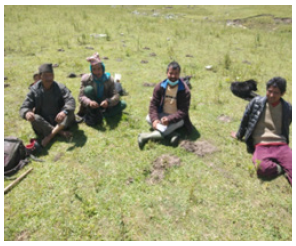
Figure 2:Sheep resting after coming down from Patan.

Transhumance system (migratory sheep flock): During the rainy season most of the farmers took their sheep to upper hills or mountain area (Patan) where there were no trees, only small shrubs and herbs were present. This study resembles a report by Sapkota et. al. [3]. Migratory sheep movement ranged from elevation of 1250m to 4500m during various seasons (Ghimire and Chapagain, 2020). Sheep grazed herbs there, no trees or shrubs were found. Buki (Anaphalis controta) is a typical grass there that was highly nutritious. From June to the first week of September, farmers kept their sheep and goats in high hills pastureland called patan. Those farmers who had large flocks, they took their sheep themselves singly, without mixing with other flocks. Those farmers who had small sheep flocks combined 4/5 such small flocks/herds and make a larger flock/herd. In such a combined flock, farmers made rotation of grazing duty for sheep. Generally, two or three members stayed in the shed for a week or 10 days. After this completion of their turn/duty, they went home to bring food ration for them, and other members stayed in the shed. In this way, rotation of the members took place when they went to high hills (Patan). They brought their sheep down towards the basin in the first week of September resemble with a report [3]. After bringing their sheep down at the basin, they kept their sheep in forest/jungle till first week of October. They also kept their sheep in growing fields under the open sky for manure. From October when vegetation was becoming scarce, they made the flock smaller. Each member took his sheep to his house. They reared themselves in small flocks till the beginning of the next warm season. The grazing cycle continues as mentioned above (Figure 3 & 5).
Figure 3:Shed of SGRP, Jumla at Patan.
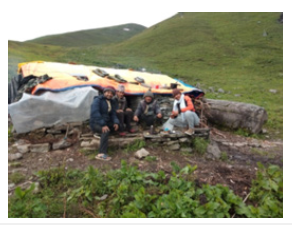
Figure 4:Sheep Grazing in Patan.
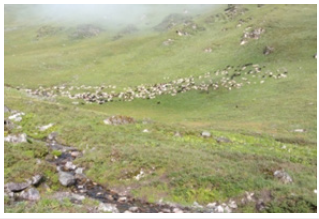
Figure 5:Pastureland at high hill called Patan (3500- 4000 masl).
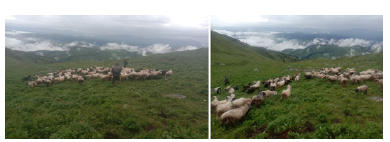
Practice of feeding salt
Since winter was very dry and animals did not get green grasses, there might be deficiency of minerals, so farmers offer salt to their sheep and goats once or twice every month. They poured the salt at one or two places on grass or on rectangular stone and all the sheep ate little by little as much as they needed (Figure 6 & 7).
Figure 6:Feeding of salt in field.

Figure 7:Feeding of salt in field.
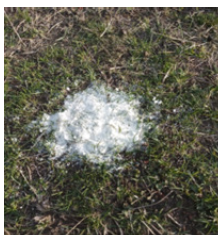
Practise of wool shearing and washing wool with Naru Tuber
Figure 8:Wool Shearing at SGRP, Guthichaur.

Wool Shearing is done twice in a year: once in March and next in September. Wool shearing is done with shearing scissors in SGRP, Guthichaur farm and in villages. Some farmers shear wool with sickle also. With shearing scissors one person can shear 6-7 sheep in a day. Naru tuber is sun dried and crushed. 10 gm of crude crushed Naru is equivalent to 6 gm of surf to wash 150gm of greasy wool. Warm water is used to wash the wool. It removes all impurities, wax and dirt. Practise of washing wool with Naru Tuber is becoming less popular due to availability of detergents/ soaps (Figure 8 & 9).
Figure 9:Sheep after wool shearing.
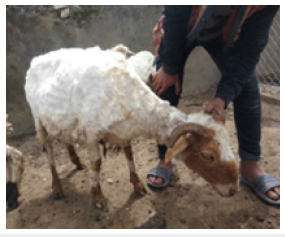
General Health Practices
Deworming
Farmers generally didnot deworm or vaccinate their sheep except few. When animals become weak, farmers deworm those individuals only.
Vaccination
They didn’t generally vaccinate their sheep against PPR and FMD although they have somehow some ideas that their sheep should be vaccinated. When some NGO’s or sub-centre from district veterinary hospital offered the vaccine, they used.
Castration
Majority of farmers performed open castration in male sheep by themselves at the age of 4/5 months. Only some farmers castrated their sheep through closed castration method using Burdizzo castrator. In open surgical castration, they did not ligate the blood vessels. They burnt the faeces of sheep and made ash, and this ash was kept in scrotum after performing castration. While other farmers used turmeric powder, antibiotic powder, povidine iodine etc. Consequently, they lost their castrated sheep due to heavy bleeding (data showed 5-6 sheep died out of 70 castrated sheep using open tradition method). Farmers near Sheep and Goat Research Program castrated their sheep with Burdizzo castrator by help of technician and applied povidine iodine on the crushed skin.
Major Health Problems
Major health problems faced by farmers were plant poisoning, parasitic infestations, scabies and lice infestation, pneumonia, abortion, uterine prolapse, vaginal prolapse and inbreeding etc as well. Few reports have been published that Pneumonia, Fascioliasis, other parasites, abortion, prolapsed, plant poisoning etc were common in sheep in Jumla [4-6].
Parasitic infestations
They applied cypermethrin (Tick out) solution soaking with cloth in Chaitra to Baishak (small scale dipping). Some farmers adopted deworming once or twice in a 2-3 years period. Generally, they used Albendazole, Oxycloznide, Piperazine etc. for all male and female sheep. They dewormed their sheep after lambing season which is Magh to Falgun. In SGRP premises, Fasciola is endemic, tapeworms were also found abundantly [4] (Figure 10 & 11).
Figure 10:Fasciola in liver of sheep.
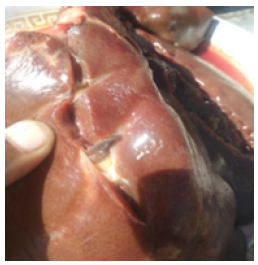
Figure 11:Fasciola extracted from liver.
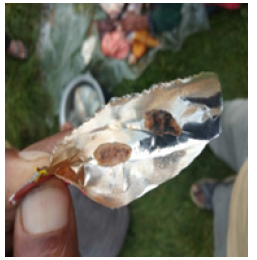
Plant poisoning
A specific type of herbal plant (locally called bikh- Aconitum species) is found in banks of rivers/streams. After consumption of this plant, the animal becomes lethargic, foaming from mouth, recumbent, bloat and finally dies. This grows in the beginning of summer season. There is less green fodder in this season, so sheep get confused thinking other plants and consume this. After consumption, if prompt treatment is not done, the animal dies. Every year almost 4-5 sheep die in each flock because of this plant poisoning. Pandey et al. [7] also reported that poisonous plants often account for a loss of up to 10-15% of lamb per year in the moving flock, especially during the spring season near the summer pasture. Atropine sulphate injection @0.4mg/kg b.wt. and sodium thiosulphate @5-10gm dissolved in 100-200ml water were used to counteract poisoning. Oral drenching of sodium thiosulphate immediately after poisoning reduced the mortality to 90-95% (Figure 12).
Figure 12:Poisoning plant Bikh (Aconitum sps) found on banks of rivers.

Uterine and vaginal prolapse
Uterine and vaginal prolapsed cases were seen occasionally. One sheep in Kolte village, nearby farm had uterine prolapsed during study period (Figure 13).
Figure 13:Vaginal prolapse in sheep.
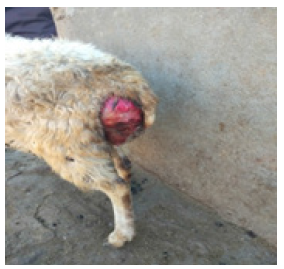
Pneumonia
Figure 14:Yellow fibrin deposition around lungs.
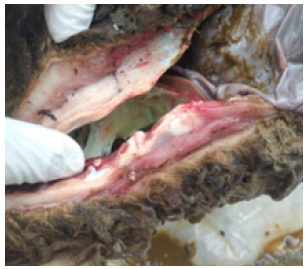
Because of the coldness occurred in some sheep, pneumonia gradually occurred and finally sheep died. During winter, the animals were kept in shed, suffocation may be there. But in the rainy season when the sheep were taken to Patan, they were kept under open sky along with cold environment. There were no clinical services available in Patan (high hills). The shepherds carried some general medicines for first aid in patan. Postmortem of the dead sheep showed yellowish fibrin like materials that surrounded the lungs. Its lungs had yellowish fibrin, marbling of lungs and multiple necrotic foci throughout the lungs (Figure 14 & 15).
Figure 15:Multiple large necrotic foci/spots in lungs.

Inbreeding problems
Farmers kept the same male for seed material in the flock for many years. It is difficult to convince them that inbreeding occurs when the same male is kept in herd for many years. Farmers thought that large sized rams were better than smaller ones and they kept the same large ram in their flock for many years. Adhikari et al. [8] mentioned in a study that most of the flocks in migratory system used the same breeding buck for 4-5 years without considering inbreeding effects. The average body weight of one year old male sheep in farmers’ condition was 12-13kg whereas in Sheep and Goat Research Programme (SGRP), it was 20-22kg [9].
Conclusion
Rearing system about sheep migratory flock was tradition in hilly region nowadays also. Sheep are taken to high hills pastureland called patan from June to first week of September in order to get nutritious grasses, ad lib grazing, safe from very hot climate below. This system utilizes the unused green fodder available in high land pastures, investment is less Pastureland can be utilized as urbanization increases day by day. Major health problems faced by farmers were plant poisoning, parasitic infestations, scabies and lice infestation, pneumonia, abortion, uterine prolapse, vaginal prolapse and inbreeding etc as well.
Acknowledgement
The authors would like to acknowledge all the farmers who actively participated in the survey as well as all the staff of Sheep and Goat Research Program, Guthchaur, Jumla for their support and cooperation.
References
- Tiwari KR, Sitaula BK, Bajracharya RM, Raut N, Bhusal P, et al. (2020) Vulnerability of pastoralism: A case study from the high mountains of Nepal. Sustainability 12(7): 27-37.
- Joshi BR, Jacobs DE (1997) Epidemiology of gastrointestinal nematode infection in sheep and goats reared under transhumance management in the Himalayan foothills of western Nepal. LARC Seminar Paper (Nepal). Lumle Agricultural Research Centre.
- Sapkota A, Sapkota B, Khatiwada S, Neupane G (2020) Transhumant goat and sheep husbandry practices in high hills of annapurna conservation area. International Journal of Environment, Agriculture and Biotechnology 5(5).
- Sah RP, Yadav MP, Kanu SP, Rijal TR (2020) Study on ovine fascioliasis: Case study, associated risk factors and economic significance at Sheep and Goat Research Program, Guthichaur, Jumla, Nepal. International Journal of Veterinary Sciences and Animal Husbandry 5(4):164-168.
- Sah RP, Yadav MP, Kanu SP (2021) Study on association of different animal and management factors on occurrence of Pneumonia in sheep in Jumla. Nepalese Journal of Agricultural Sciences 21:110-118.
- Sah RP, Yadav MP, Kanu SP, Ali Md SN, Talukder Md H (2022) Cross sectional study of diseases and disorders in sheep at Sheep and Goat Research Program, Guthichaur, Jumla, Nepal. Nepalese Journal of Agricultural Sciences 22: 65-71.
- Pandey LN, Gyawali R (2012) Constraints and potential of goat and sheep production under transhumance management system in the high mountainous regions of Nepal. Research and Development Strategies for Goat Enterprises in Nepal, pp. 92-101.
- Adhikari D, Adhikari DP, Sharma MP, Nepali DB, Kolachhapati MR, et al. (2020) Livestock movement in Gaurisankhar Valley, Dolakha, Nepal. The Geographic Base 7: 15-23.
- Sapkota S (2013) In Migratory System of Baruwal Sheep Production in Nepal: Problem and Prospect. Proceedings of the 9th National Workshop on Livestock and Fisheries Research in Nepal, pp.191-196.
© 2023 Ramesh Prasad Sah. This is an open access article distributed under the terms of the Creative Commons Attribution License , which permits unrestricted use, distribution, and build upon your work non-commercially.
 a Creative Commons Attribution 4.0 International License. Based on a work at www.crimsonpublishers.com.
Best viewed in
a Creative Commons Attribution 4.0 International License. Based on a work at www.crimsonpublishers.com.
Best viewed in 







.jpg)






























 Editorial Board Registrations
Editorial Board Registrations Submit your Article
Submit your Article Refer a Friend
Refer a Friend Advertise With Us
Advertise With Us
.jpg)






.jpg)














.bmp)
.jpg)
.png)
.jpg)










.jpg)






.png)

.png)



.png)






